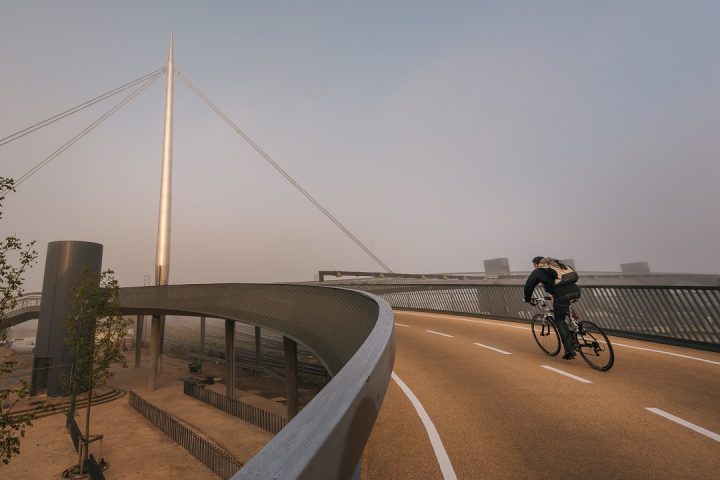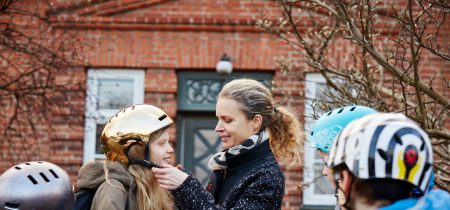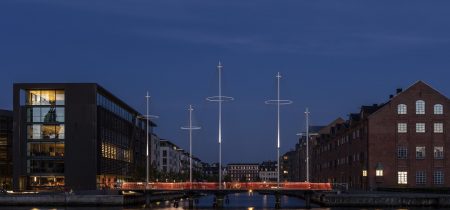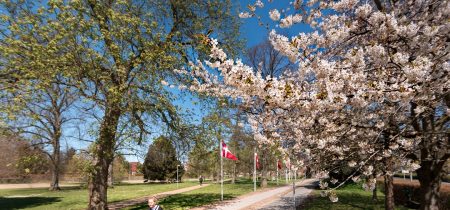Materials, construction, and aesthetics
The choice of materials is crucial both for aesthetic reasons and so road users know where to go. In addition, the type of construction is crucial for the infrastructure’s long term durability, and whether it’s still attractive several years along the line.
By Troels Andersen, Odense Municipality
If you don’t want city streets to be mere traffic arteries but attractive and pleasant spaces as well, you need to work with the whole picture.
Architects, engineers and landscape architects must cooperate and gain insight into each other’s professional fields. A common issue when squares and other areas are being reconstructed is the type of surface to use. The aesthetic standpoint favors a uniform surface, whereas the traffic safety standpoint prefers different surfaces to indicate different traffic functions – the classical form vs. function dilemma.
Individual road user groups experience surfaces very differently. The cyclist’s line of vision is naturally downwards, and for the cyclist the cycling surface is important for the total experience of the street space.
Asphalt
The best material for cycle tracks is asphalt, which is why asphalt is the standard surface on Danish cycle tracks. Asphalt provides an even surface, and can be repaired as a matter of routine.
Asphalt concrete is produced by mixing hot, soft bitumen and stony materials. Asphalt concrete is excellent as a cycle track wearing course and normally has a technical lifetime of 15-20 years, although it may not remain even for more than 10 years. Asphalt concrete’s smooth surface and low friction make it easy and pleasant to cycle on, and it comes in many colors. Asphalt should always be applied mechanically to ensure an even finish.
Gravel
Gravel should not be used on cycle tracks, although it may be used if the cycle track doesn’t need to be passable in snow and there is no need for road markings. Recreational tracks may be laid down with a rockdust surface, which is good for cycling. Another type of gravel that provides a good cycling surface is castle gravel (and similar terms). This material has the additional advantage that it can be laid down all at once, and can serve as the wearing course and the base course. The surface cannot be swept or snow cleared.
A light surface treatment is the cheapest solid coating. It’s similar to gravel and can be a compromise in natural areas where there is a reluctance to use asphalt.
Paving slabs
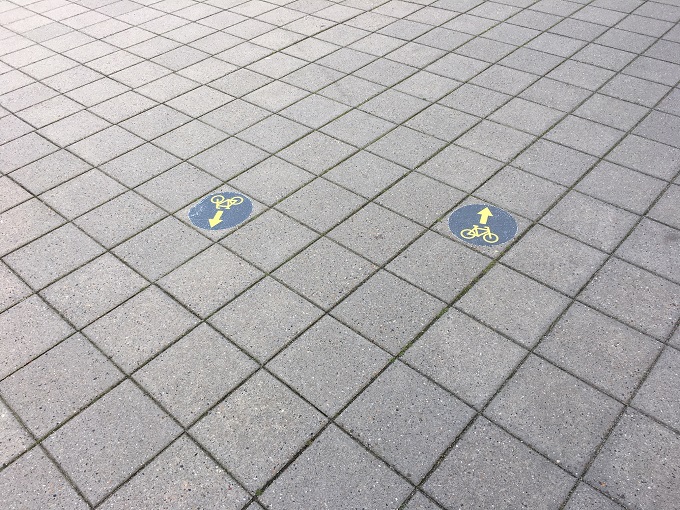
- It somehow just seems wrong to cycle on paving slabs. Here, however, is a temporary situation where it was necessary to mark cyclist positioning. Photo: Troels Andersen.
Granite paving slabs normally indicate a pedestrian area. Large paving slabs tend to settle over time and become uneven. Paving stones and chaussée stones are also much more uneven than asphalt but may be slightly improved by sawing to make them more even and jet burning to reduce friction. Paving slabs, paving stones and the like should not be used on cycle tracks, and only to a limited extent elsewhere, for example in a row as a means of sharpening awareness of cycling facilities across squares.
Cycling spaces in pedestrian areas can be separated from the pedestrian area by a 3 cm high vertical kerb. It is important that cyclists are allowed to cross squares legally as they otherwise often have to take the long way round.

- Aesthetics can be enhanced by combining form and function, as shown in the bike above. Photo: Troels Andersen
Coloured road surfaces
In the case of more regulated traffic areas the choice of surface and colour can clarify where each road user group should go. Surface and colour choice should help road users understand the use of each area and who has the duty to yield. Sometimes it’s up to the road users themselves to negotiate their interaction. In this case planners must try to predict what cyclists will do.
When the colour of a surface stands out from its surroundings, a given traffic area becomes more visible and right of way clearer. An example of this is coloured asphalt or blue, thermoplastic cycle crossings. When different colour materials are used, for example red asphalt on cycle tracks as in Nakskov, it’s important to use the same material for repairs. Some coloured surfaces lose their colour over time and consequently some of the colour’s effect is lost. It can start to look shabby and worn out.
Construction
For reasons of comfort and safety cycle tracks should be constructed with an even surface with enough friction. The construction should be able to resist pressure from the motor vehicles that use it, for example maintenance materials and illegally parked trucks. It’s a good idea for the road bed to continue underneath the cycle track along roads with no verge.
On cycle tracks with their own layout the base course should be constructed in such a way that maintenance vehicles don’t make ruts or cracks on the side of the cycle track, which is a typical problem.
Reinforced cycle lanes
The optimal solution, i.e. the classical cycle track, is not always possible. Local authorities have addressed this issue in a number of ways:
- Frederiksberg has installed cycle lanes with a few reinforcements such as traffic islands.
- Copenhagen has used the “reinforced cycle lanes” solution for certain periods of time. These are basically cycle lanes, which are cheap to establish when the kerb doesn’t need to be moved. Cycle lanes are reinforced in certain spots by a traditional cycle track, at bus stops, for example.
- Aalborg has established long cycle lane stretches on Hadsundvej reinforced with cycle tracks over side roads.
Sources
Smukke Veje – En håndbog om vejarkitektur, Vejdirektoratet, 2002


